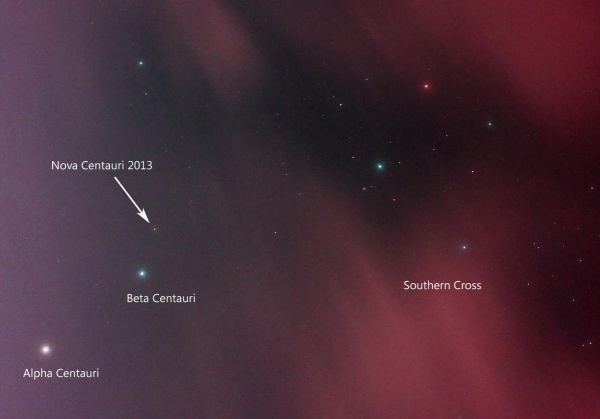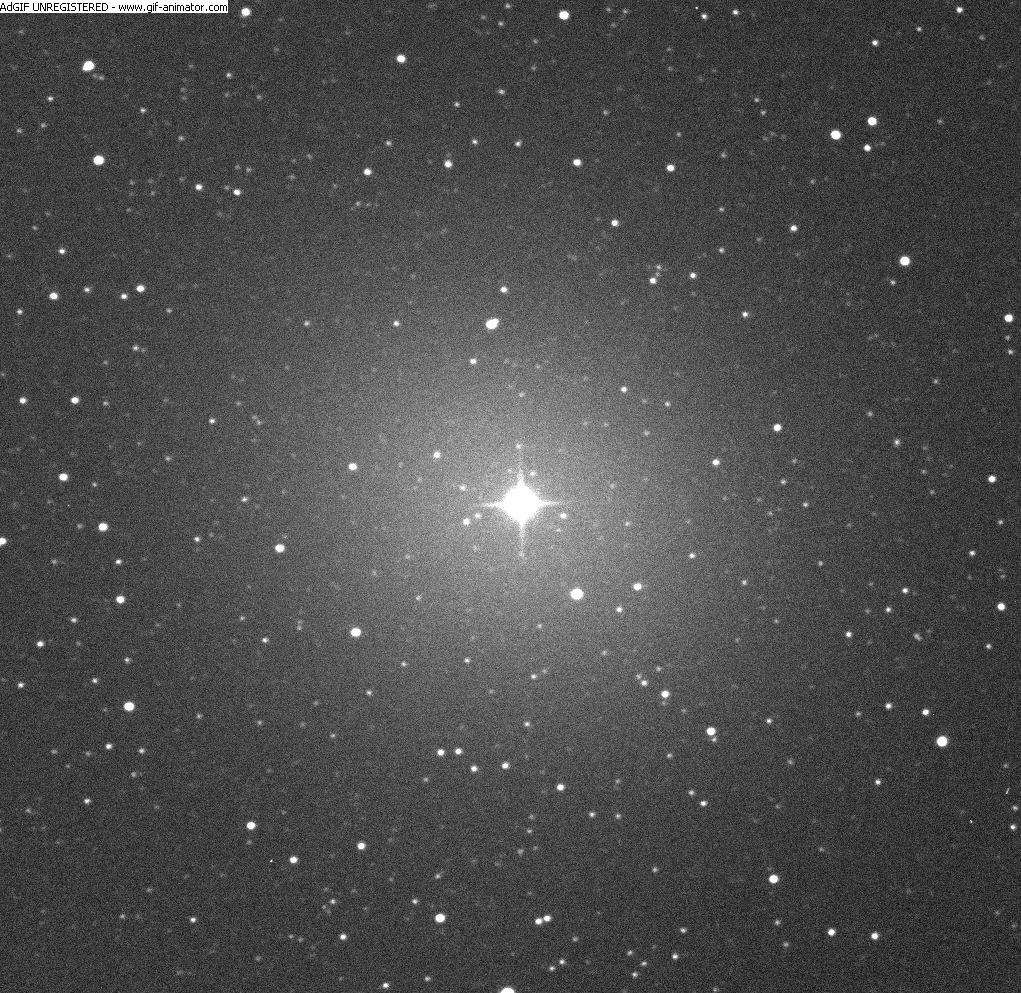It looks like you're using an Ad Blocker.
Please white-list or disable AboveTopSecret.com in your ad-blocking tool.
Thank you.
Some features of ATS will be disabled while you continue to use an ad-blocker.
17
share:
In recent nights, there has been a new light in the sky.
Unfortunatly for most readers here, you do have to live in the southern hemisphere to see it (or at least, somewhere near the equator).
Proving once again that NASA are *NOT* the gatekeepers of celestial happenings, this nova was discovered by an amateur astronomer with nothing more than a Digital SLR camera with a 50mm lens.
It is being discussed in various astronomy forums, such as iceinspace.

It is said to be easily visible to the naked eye, but have I seen it?
Nope.
I've seen clouds and rain.
Unfortunatly for most readers here, you do have to live in the southern hemisphere to see it (or at least, somewhere near the equator).
Proving once again that NASA are *NOT* the gatekeepers of celestial happenings, this nova was discovered by an amateur astronomer with nothing more than a Digital SLR camera with a 50mm lens.
It is being discussed in various astronomy forums, such as iceinspace.

It is said to be easily visible to the naked eye, but have I seen it?
Nope.
I've seen clouds and rain.
reply to post by alfa1
Man thats cool.
I have no idea what a Centuari' is, but it must be important if it's causing a buzz!
Man thats cool.
I have no idea what a Centuari' is, but it must be important if it's causing a buzz!
brace22
I have no idea what a Centuari' is...
Its the name of the constellation.
Its supposed to be a Centaurus, half-man half-horse thing from Greek mythology.
reply to post by alfa1
You can tell I think stars a nice, but no idea what's what up there haha
Thanks!
You can tell I think stars a nice, but no idea what's what up there haha
Thanks!
reply to post by alfa1
Your title is misleading. It should say "NASA aren't the gatekeepres of celestial events".
I'm confused. Should we talk about Nova or how NASA are the good guys?
Your title is misleading. It should say "NASA aren't the gatekeepres of celestial events".
I'm confused. Should we talk about Nova or how NASA are the good guys?
Found another link with some really good info on the nova.
Universe Today
Really hate I can't pull the telescope out and view this.
Universe Today
Really hate I can't pull the telescope out and view this.
reply to post by alfa1
One before and after pic.

Hay brace22 there lots of free astronomy software out there like
stellarium to help you find things.
One before and after pic.

Hay brace22 there lots of free astronomy software out there like
stellarium to help you find things.
edit on 6/12/2013 by skuly because: If you stare at the gif to long your eyes go funny
reply to post by alfa1
nice find , im no expert here but my question is , is it going to get bigger gradually or is it going to stay like that , is it an explosion of a star or is it a new star
nice find , im no expert here but my question is , is it going to get bigger gradually or is it going to stay like that , is it an explosion of a star or is it a new star
Knowing nothing about celestial events, how long do these typically remain for us to see? Wouldn't it just be a flash and then gone if it was a
supernova? I just don't understand how a star can blow up and then the light remains there, for what seems like awhile. Or is it just the lead up
to the explosion that is seen?
Thanks in advance.
Thanks in advance.
Ok nice to know taht bright light (star?? way to bright large wired .
plan nope not moving .Planet ? wrong place wrong time of night.
Exploding star ooo wish I had known would have looked harder.
plan nope not moving .Planet ? wrong place wrong time of night.
Exploding star ooo wish I had known would have looked harder.
LOL I have never thought of using my 50mm for anything other than portraits...
If I ever get some clear skies again and some warmer than 8° at night I will test it out on my new scope mount I still have yet to use!
D'OH! Missed the part were it was a 50 mm f/1.0 lens!!! Damn would love a fast lens like that too!
If I ever get some clear skies again and some warmer than 8° at night I will test it out on my new scope mount I still have yet to use!
D'OH! Missed the part were it was a 50 mm f/1.0 lens!!! Damn would love a fast lens like that too!
edit on 6-12-2013 by abeverage
because: of fast lenses...
reply to post by superman2012
Nova via Wiki
So they can last a long time.
Subtypes[edit]
Novae are classified according to the light curve development speed, thus in
NA: Fast novae, with a rapid brightness increase, followed by a brightness decline of 3 magnitudes — to about 1⁄16 brightness — within 100 days.[11]
NB: Slow novae, with a 3 magnitudes decline in 150 days or more.
NC: Very slow novae, staying at maximum light for a decade or more, fading very slowly. It is possible that NC type novae are objects differing physically very much from normal novae, for example planetary nebulae in formation, exhibiting Wolf-Rayet star like features.
NR/RN: Recurrent novae, novae with two or more outbursts separated by 10–80 years have been observed.[12]
Nova via Wiki
So they can last a long time.
edit on 6-12-2013 by LightAssassin because: (no reason given)
RammerJammer
Found another link with some really good info on the nova.
Universe Today
Really hate I can't pull the telescope out and view this.
ARGH, you and me both!
Why is the most interesting stuff always happening in the southern hemisphere skies!??!
edit on 6-12-2013 by JadeStar because: (no reason
given)
LightAssassin
reply to post by superman2012
Subtypes[edit]
Novae are classified according to the light curve development speed, thus in
NA: Fast novae, with a rapid brightness increase, followed by a brightness decline of 3 magnitudes — to about 1⁄16 brightness — within 100 days.[11]
NB: Slow novae, with a 3 magnitudes decline in 150 days or more.
NC: Very slow novae, staying at maximum light for a decade or more, fading very slowly. It is possible that NC type novae are objects differing physically very much from normal novae, for example planetary nebulae in formation, exhibiting Wolf-Rayet star like features.
NR/RN: Recurrent novae, novae with two or more outbursts separated by 10–80 years have been observed.[12]
Nova via Wiki
So they can last a long time.edit on 6-12-2013 by LightAssassin because: (no reason given)
That is amazing! Imagine if it were happening closer!
new topics
-
Proof of Cleptocracy
US Political Madness: 1 hours ago -
Boy Scouts to be renamed next year
Other Current Events: 5 hours ago -
Pfizer agrees to settle over 10,000 Zantac lawsuits after cancer causing substance found in drug
Medical Issues & Conspiracies: 6 hours ago -
Judas Iscariot Slips The Hangman's Noose
Political Issues: 9 hours ago -
Murder Suicide Investigation Still Active 4 months later?
Other Current Events: 9 hours ago -
A Shout-out To truthseeker45 Hoot Hoot
General Chit Chat: 11 hours ago
top topics
-
Ooooh...it worked!!
Members: 14 hours ago, 17 flags -
Judas Iscariot Slips The Hangman's Noose
Political Issues: 9 hours ago, 10 flags -
New House GOP Bill To Send Pro Hamas College Law Breakers to Gaza for 6 Months
Social Issues and Civil Unrest: 16 hours ago, 9 flags -
A Shout-out To truthseeker45 Hoot Hoot
General Chit Chat: 11 hours ago, 4 flags -
Pfizer agrees to settle over 10,000 Zantac lawsuits after cancer causing substance found in drug
Medical Issues & Conspiracies: 6 hours ago, 4 flags -
Murder Suicide Investigation Still Active 4 months later?
Other Current Events: 9 hours ago, 3 flags -
Boy Scouts to be renamed next year
Other Current Events: 5 hours ago, 2 flags -
Proof of Cleptocracy
US Political Madness: 1 hours ago, 1 flags
active topics
-
Boy Scouts to be renamed next year
Other Current Events • 30 • : BeyondKnowledge3 -
Breaking--Hamas Accepts New Cease Fire
Middle East Issues • 295 • : Xtrozero -
Pentagon UFO Hunter Reveals What He Knows About Aliens: Nothing
Aliens and UFOs • 10 • : crayzeed -
Proof of Cleptocracy
US Political Madness • 2 • : VariedcodeSole -
New House GOP Bill To Send Pro Hamas College Law Breakers to Gaza for 6 Months
Social Issues and Civil Unrest • 89 • : network dude -
Judge Postpones Trump Classified Docs Trial INDEFINITELY
US Political Madness • 141 • : CarlLaFong -
FBI confirms new leads connected to DNA evidence and cellphone data in disturbing killings of elderl
Other Current Events • 13 • : TheMisguidedAngel -
Don’t Obstruct the Leftist Implosion
US Political Madness • 34 • : network dude -
Pfizer is 'deeply sorry'
Diseases and Pandemics • 33 • : PrivateAngel -
Judas Iscariot Slips The Hangman's Noose
Political Issues • 22 • : watchitburn
17
